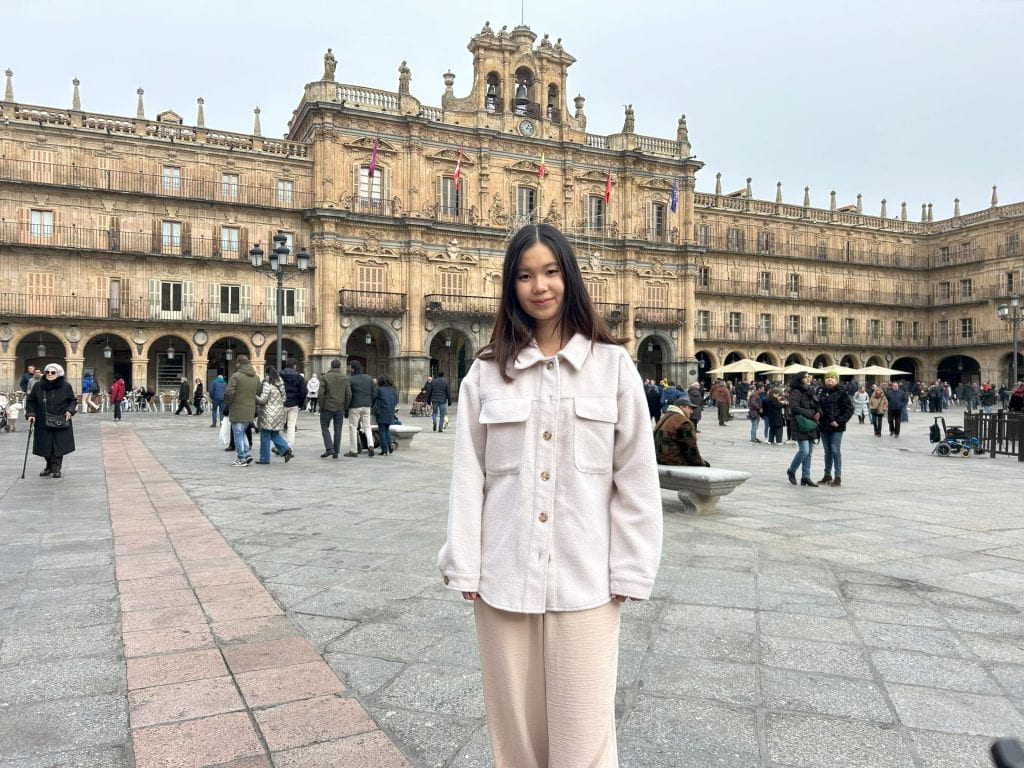Immigration in Spain: Past, Present, and Future

After months of preparing for my semester abroad, I finally arrived in Spain, and even until this moment, everything still felt quite surreal. It was not until I got to Salamanca and saw the endless sandstone walls and buildings that I realized my study abroad experience had officially begun. This beautiful city was where I was going to spend my entire semester.
After settling in during the first few days, I began planning to learn more about immigration in Spain. To be honest, I wasn’t sure how to start. I could’ve done research on the internet, but I wanted to dive deeper into this topic through a more local perspective, like walking on the streets and asking the local Salmantinos. I explored the city while keeping this topic in mind, looking around to see if I noticed anything having to do with the immigration history or situation of Salamanca.
Something I immediately noticed was the lack of international cuisine in the main city center, which is the old part of the city with the cathedrals, Plaza Mayor, and the University of Salamanca. Considering I saw countless international cuisine restaurants I noticed in Madrid’s main parts of the city, this was definitely a difference between Madrid and Salamanca. This may seem irrelevant, but something I’ve learned through experience is that the number of international restaurants is usually somewhat proportional to the population of immigrants in that area. Although this observation isn’t always 100% accurate, I thought it was a good place to start my investigation.
During my Spanish class, I brought this up and asked my professor if she knew any global cuisine restaurants in Salamanca. She told me that compared to Madrid, where she grew up, Salamanca had very limited global cuisine, and very few restaurants were located in the Barrio del Oeste, a neighborhood on the outskirts of the city. My curiosities led me to the Barrio del Oeste, as I searched for restaurants that my professor had mentioned. I finally found a Chinese dim sum place and a Mexican restaurant! As I munched on a few dim sums, I was hesitant to ask the owners about immigration in Salamanca, but luckily, they started the conversation by asking where I was from! I told them I was a student from the US, and I was born in Korea. The owners told me that they were immigrants from China and had moved to Salamanca and started a dim sum place together. I learned from them that while Salamanca definitely has fewer immigrants than bigger cities like Madrid, Barcelona, or Valencia, there were many immigrants from various places. I was thrilled after gaining an insightful local perspective on the topic of immigration in Spain.
My next step was to understand the long history and current situation of immigration in Spain. I wasn’t exactly sure where to begin besides looking on the internet, but I thought of my history professor as the perfect individual who could speak about this topic. I took a course called “The Cultures of Spain: Understanding Past, Present and Future” during my time abroad, and as the name suggests, I was able to learn about how the history of the past has impacted Spain’s culture throughout the years and continues to impact the nation today.
I met with my professor, Tamar Groves, to ask her about the history of immigration in Spain. I learned from her that in the past, Spain was known for emigration, not immigration. Especially during the Spanish Civil War (1935-1936) and the Franco dictatorship, the violence and political retaliation led to many Spaniards fleeing to other European countries and Latin America. After this long history of emigration, the post-Franco era, beginning in 1975, is when immigration in Spain dramatically increased. As political freedom was guaranteed and the nation saw economic growth, Spain began to attract immigrants from all over the world. Most of the immigrants were from other European countries, Latin America, and North Africa. Going into the 21st century, immigration in Spain continued to rise until the financial crisis of 2008. Spain faced severe economic hardships from this event, putting many people out of work. Since then, immigration has dwindled compared to before. However, Spain now faces a problem with refugees, which has been a factor of political tension for the past few years, including the tense elections this summer and fall.
After looking further into the issue of refugees in Spain, I found that there is a very negative view towards them. Particularly when reading articles about refugees, most of them include negative connotations describing the subject, and one classmate of mine wrote a research paper about the impact of negative articles on refugees in Spain. This negative view was particularly driven by Spain’s current issue with high unemployment rates, especially among young adults and college graduates. Ironically, a majority of Spanish college graduates emigrate out of Spain to find jobs in other countries to support their families in Spain. These issues continue to bring negative views towards refugees.
I’ve actually walked into a representation of this sentiment in the Barrio del Oeste, a neighborhood full of urban art. I found a mural depicting a child resembling a refugee, looking lost and carrying animals behind his back. This current issue of immigration into Spain is evident in many aspects of Spain’s current events, and it is expected to continue impacting Spain’s future social and political tensions. It was very insightful to look into this topic from a somewhat local perspective.